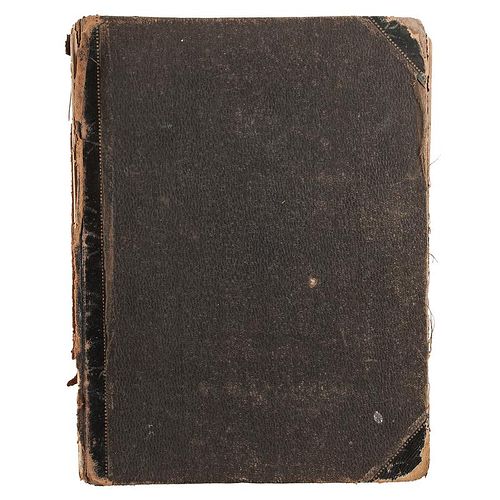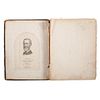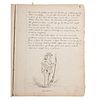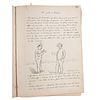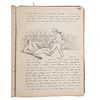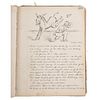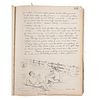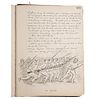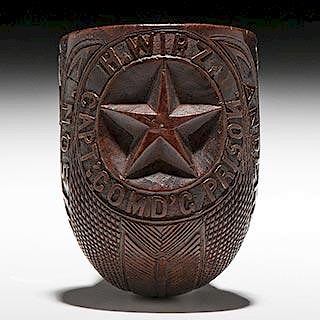Original Story, Silas Clack History of the Common Soldier in the Civil War Written and Illustrated by Civil War Veteran, P.M.
About Seller
6270 Este Ave.
Cincinnati , OH 45232
United States
With offices in Cincinnati, Cleveland and Denver, Cowan’s holds over 40 auctions each year, with annual sales exceeding $16M. We reach buyers around the globe, and take pride in our reputation for integrity, customer service and great results. A full-service house, Cowan’s Auctions specializes in Am...Read more
Two ways to bid:
- Leave a max absentee bid and the platform will bid on your behalf up to your maximum bid during the live auction.
- Bid live during the auction and your bids will be submitted real-time to the auctioneer.
Bid Increments
| Price | Bid Increment |
|---|---|
| $0 | $25 |
| $500 | $50 |
| $1,000 | $100 |
| $2,000 | $250 |
| $5,000 | $500 |
| $10,000 | $1,000 |
| $20,000 | $2,500 |
| $50,000 | $5,000 |
| $100,000 | $10,000 |
About Auction
Feb 21, 2017 - Feb 22, 2017
Cowan's Auctions dawnie@cowans.com
- Lot Description
Bound manuscript, 255 pp, entitled Silas Clack History of the Common Soldier in the Civil War, written and illustrated by Phillip M. Radford, 5th Tennessee Cavalry, Co. A, and 1st Alabama Vidette Cavalry, Co. F.
A peculiar native of Tennessee, Phillip M. Radford went against the allegiance of his home state and enlisted in the Union Army at Nashville on August 19, 1862. He mustered in as a private of the 5th Tennessee Cavalry, Co. A, commanded by Colonel W.B. Stokes. He was promoted to sergeant major, then took command of the 1st Alabama Vidette Cavalry, Co. F, as a 1st lieutenant. He narrowly escaped capture from Morgan's Raiders on a recruiting mission in Tennessee. Radford wrote about his experience, and the Nashville Daily Union published it on May 17, 1862. While assisting his men moving a wagon, he ruptured the right side of his abdomen. The internal injury festered for a few days, causing an infection that made him unfit for service. He was honorably discharged on June 16, 1864. Instead of leaving the army, he became a clerk until the war's end. After the war, he became commander of GAR Post No. 1 Department of Tennessee and Georgia. Inspired by his war experience, Radford took his pen to paper again, this time, writing a fictional account of a soldier named Silas Clark. In the preface of the book, he wrote:
The experience of Si Clack recorded in this book is the story of thousands who were privates in the Federal Army. Since the war ended numerous histories of prominent men have been written. Desperate and bloody battles have been recorded and spread broadcast for the information of the world. The history of the common soldier has yet to be written. So then was the task set to whip a determined enemy and they did it. This story was given in several lectures to the Grand Army Post as camp fire stories. They were thought to be too good to throw aside and hence preserved in book form.
P.M. Radford
Commander Gen. H Thomas Post
No.1 G.A.R.
Nashville, Tennessee
November 6, 1885
The protagonist, Clack enlisted in the army based on patriotism. He served for three years in an unidentified company. Before his departure, his family tearfully gave him gifts they thought he would need at the front. His mother knitted him a few pairs of socks, his sisters gave him soap and a family photo album, and his father had the shoemaker make him the best pair of boots. During his service, Clack took a prisoner and saw action at the Battle of Stone's River. In between the stories, Radford drew over 70 illustrations, both comical and mundane, that were familiar to every soldier. Near the conclusion of the story, he begins with a poignant explanation of what soldiering is and why men enlisted. He wrote:
On the whole perhaps boys like adventure and excitement, fine dress, the pride of fame, all of which are sentimental motives that makes them like going into "the Guards" better than into the counting house. They fancy that there is a severe sense of duty missed with these peacocky motives.
There is true duty done in raising harvests and houses than in burning them. There is more in winning money by your own work than in taxing other peoples work for money wherewith to slay men. And if you are a sentimental fellow you chose to brave death in a red coat than a black one.
But after a while you find that you have put yourself into the hands of your country as a weapon. You have vowed to strike when you are bid and to stay the scabbard when they bid you. But remember all this is a state of slavery. There are different kinds of slaves and different masters. Some are bought with money and others with praise. It matters not what the purchase of money is. The sign of slavery is to have a price and be bought for it...some slaves are set to digging others to forced marches some dig furrows others graves. Some press the juice of vines and some the blood of men.
He ends with a powerful illustration of two men who spend their money on curtains or steel traps. The man who buys the steel traps sets them on either side of the wall with a good friend because, he could not possibly keep on friendly terms without them. It is a creative illustration of the Union and Confederacy after the war. Radford encourages veterans on either side of the wall not to set traps for each other and to not prepare for war in a time of peace.
Provenance: N. Flayderman and Co., Inc.Fragile binding, with little to no spine left; wear on the cover and toning of the paper. There are no missing pages in the book and the handwriting is clear an legible.Condition
- Shipping Info
-
SHIPPING. At the request of the buyer, Cowan's will authorize the shipment of purchased items. Shipments usually occur within two weeks after payment has been received. Shipment is generally made via UPS Ground service. Unless buyer gives special instructions, the shipping method shall be at the sole discretion of Cowan's Auctions, Inc.. Cowan's is in no way responsible for the acts or omissions of independent handlers, packers or shippers of purchased items or for any loss, damage or delay from the packing or shipping of any property.
-
- Buyer's Premium



 EUR
EUR CAD
CAD AUD
AUD GBP
GBP MXN
MXN HKD
HKD CNY
CNY MYR
MYR SEK
SEK SGD
SGD CHF
CHF THB
THB